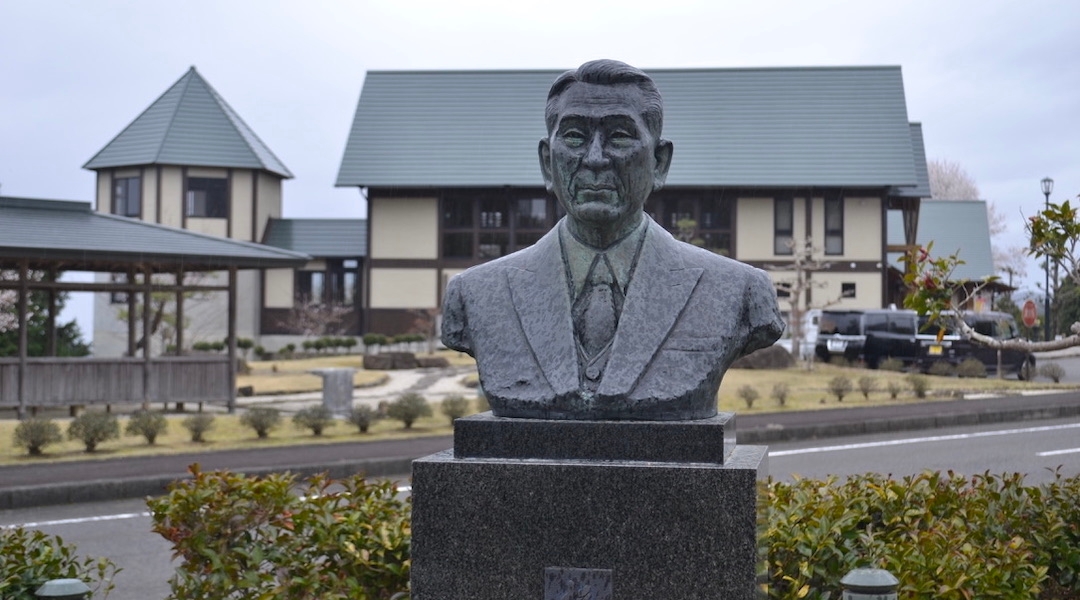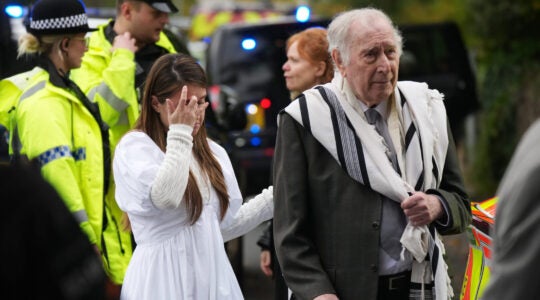YAOTSU, Japan (JTA) — Three years before the Olympics began in 2021, Tokyo was already developing the national image it would display as the world looked on.
The Tokyo Metropolitan Board of Education issued a handout to the city’s public schools in 2018 highlighting “the outstanding achievements of our predecessors” that were meant to “raise [students’] self-awareness and pride as Japanese.”
Occupying a majority of the four-page handout was the story of diplomat Chiune Sugihara, who wrote thousands of life-saving visas for Jews fleeing Europe in 1940. The pamphlet recreates a dramatized version of Sugihara’s life and actions, bolstered by quotes from nameless descendants of the Jewish refugees he saved.
“Sugihara should be remembered and honored as an amazing hero who sacrificed his profession and family to save strangers from a different ethnicity and culture,” one of the quotes reads.
Sugihara, a Japanese diplomat to Lithuania from 1939 to 1940, helped thousands of Jewish refugees flee wartime Europe by issuing transit visas that allowed them to travel across the Soviet Union to Japan. Today, his name and story can be found all over the country, from his supposed hometown in Yaotsu to a museum at the northern Tsuruga port where Jewish refugees landed.
His likeness is found in memorials in Tokyo and in manga series and films, in addition to nearly every modern history school textbook. In 2017, the Tokyo Weekender magazine dubbed Sugihara the “best Japanese person ever.” Some Catholics have even expressed hope that Sugihara will be officially canonized by the Catholic church as a Saint.
But over the past few years, a growing number of researchers — in addition to his own son — have publicly challenged Sugihara’s superhero status and many details of the version of his story pushed in Japan and around the world. Some researchers say that Japan has used him as a symbol of humanitarianism in the face of criticism of Japan’s World War II record.
And some note that Japan is taking the nationalist narrative one step further, by boosting another World War II-era figure whom they believe can achieve a similar level of national fame and hero status — whether or not his story is verifiable.
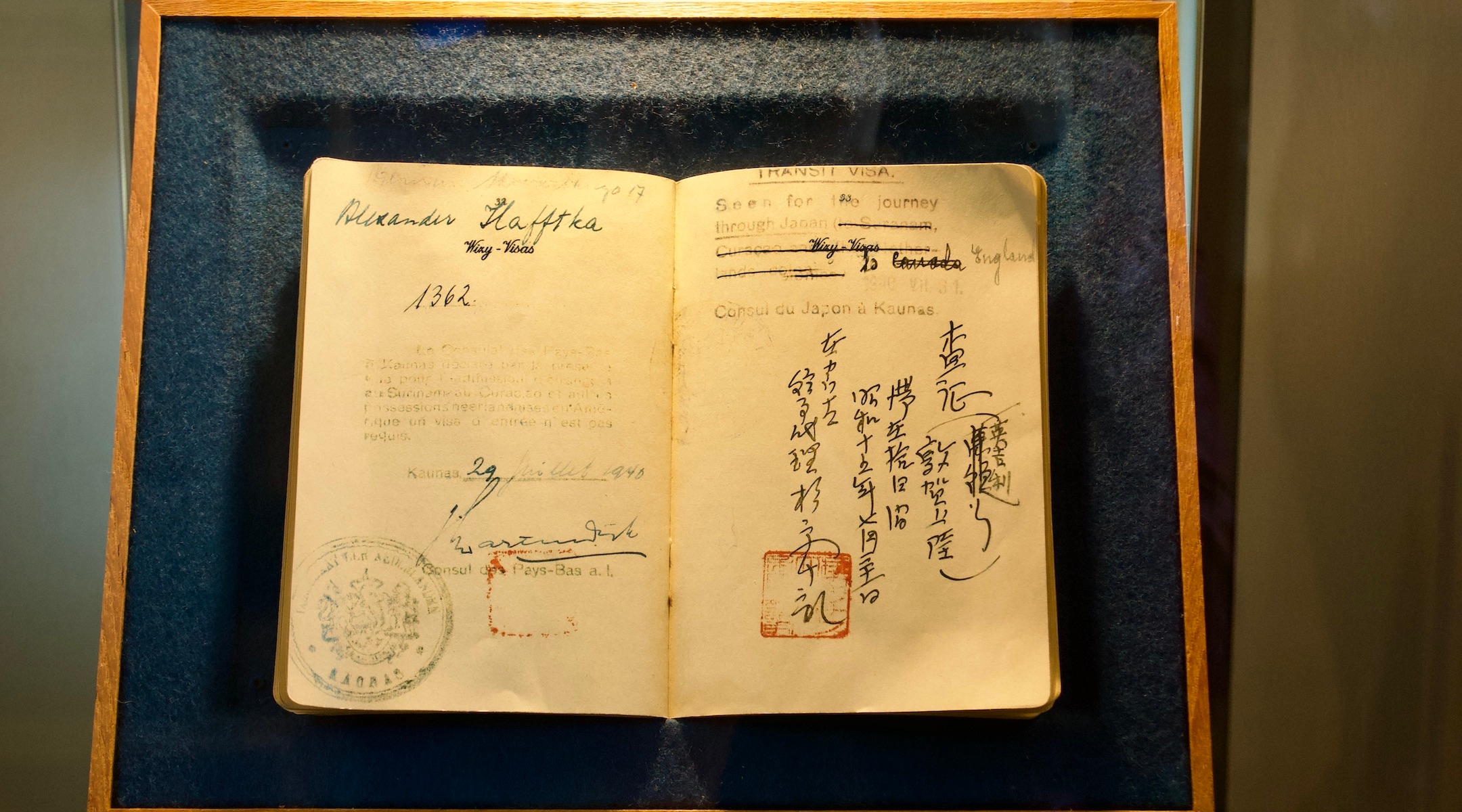
A Sugihara visa seen at the Sugihara Chiune Memorial Hall museum in Yaotsu. (Jordyn Haime)
The Sugihara story
Issuing visas was not part of Sugihara’s job description. He was stationed in Kaunas, Lithuania, from 1939 to keep an eye on Soviet military activity in the region.
But when rumors spread of a Japanese diplomat issuing transit visas, Sugihara one day found a crowd of Jews lined up outside of his home hoping they would be lucky enough to get one. They were running from the Soviets; no one had yet predicted the havoc that would be unleashed on them by the Germans when they finally invaded one year later.
Sugihara issued some 2,140 transit visas, some used for entire households. But Meron Medzini, professor emeritus at the Hebrew University of Jerusalem’s Department of Asian Studies, wrote in his 2016 book “Under the Shadow of the Rising Sun: Japan and the Jews during the Holocaust Era” that “Not all of the visas were used, and this makes it difficult to substantiate the claim that Sugihara was instrumental in helping [the commonly accepted number of] between 6,000 and 7,000 Jews leave Lithuania.”
Sugihara’s act was also only one step in a series of events that led to the refugees’ escape. Tokyo required them to have a final destination permit as a condition of their transit through Japan, and those were provided by Jan Zwartendijk, a Dutch consul in Kaunas at the time who stamped thousands of Jewish passports to visa-free Dutch Curacao. Jewish organizations stepped in to pay for the refugees’ transit across the Soviet Union, which was miraculously granted by Soviet authorities.
Andrew Jocubowicz, whose parents escaped wartime Europe with the help of a Sugihara visa, emphasized the importance of Zwartendijk’s role in an interview. In recent years, the Dutch consulate has also attempted to boost the profile of their own Holocaust hero, who is often “hidden” in the shadow of Sugihara.
“The critical person in the whole game was really Zwartendijk,” said Jocubowicz, a professor of sociology at the University of Technology Sydney who has spent four decades researching the conditions of his family’s survival. “Without those visas, it would not have happened at all. There’s no way Sugihara could have cooked up something that didn’t have people moving on from Japan.”
After arriving in Japan, Jews left for Australia, Canada, the United States and other countries. Others were later deported to Japanese-controlled Shanghai, where authorities imprisoned them in a ghetto for the remainder of the war.
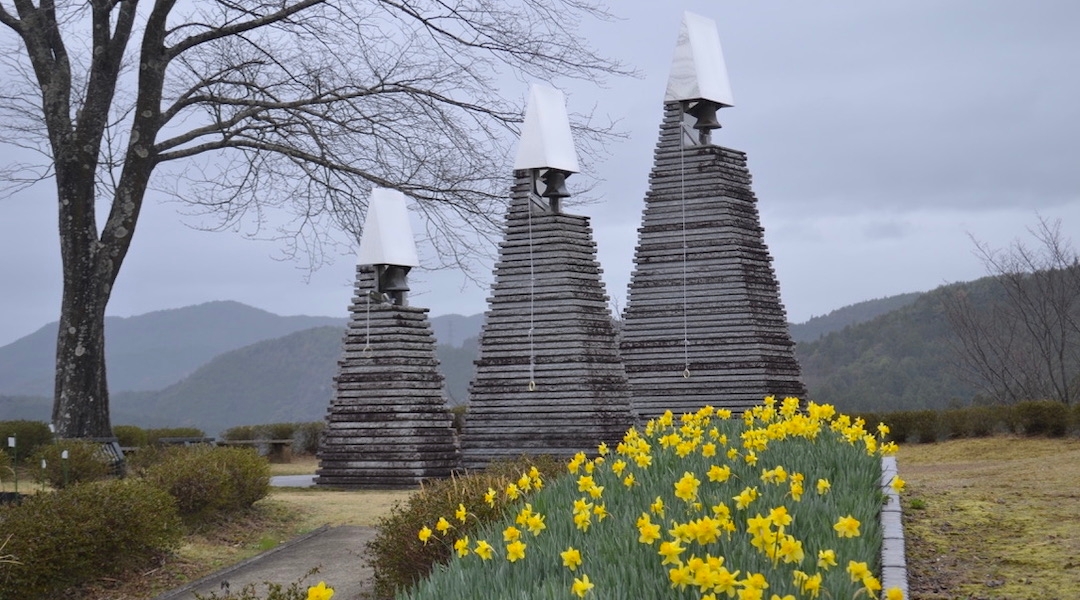
A view of the Visas for Life monument in Yaotsu, Japan. (Jordyn Haime)
The hometown museum that isn’t
Claims that Sugihara helped several thousand Jews; that his requests for visas were rejected “three times” by his superiors; and that he was dismissed and punished for his actions are all important details that make Sugihara a hero. But they are also all claims that researchers have debunked.
Jocubowicz said his father barely met Sugihara, whose visa was just one chapter in a long journey to safety. The survival of this group of Jews was “almost pure luck at every point,” he said, especially their allowance by the Soviets to cross through Russia. After several months in Kobe, his family spent the remainder of the war in the Shanghai ghetto before boarding a ship to Australia, where Jocubowicz was raised.
“My feeling is that it was an extraordinary wormhole that opened up through these essentially conflicting empires, and as they crashed into each other, this little hole opened up and people were able to scurry into it,” he said.
Yaotsu’s claim as Sugihara’s birthplace is also disputed, said Nobuki Sugihara, the consul’s only surviving child. Nobuki said that according to family documents, his father was born in Mino, about 30 miles away from Yaotsu.
“It’s shocking. People come from around the world to visit Yaotsu [but] my father was not born there, he has never lived there,” Nobuki told the Jewish Telegraphic Agency. “They made a story that he was born in Yaotsu in order to get tourists because in that village there is nothing.”
The memorial and museum in Yaotsu, despite its distance from a major city, receives 20,000 tourists per year both foreign and domestic, according to Ito Yuko, who works in Yaotsu’s regional development and promotion division. She said the Sugihara family once lived in their small town, and elderly townspeople still remember them.
“For our museum, we are telling the truth that we know. Not exaggerated, not right or left, we just tell the story that we think is true,” she said.
Local tourism officials have also promoted a “Sugihara Remembrance Route,” part of a multimillion-dollar effort promoted widely in Israel that is described as “a nostalgic journey of discovery that will take you to places associated with the great man and areas where the Japan’s [sic] original landscape and traditional culture remain strong.” Although sometimes referred to as the “refugees remembrance route,” the route curiously excludes the city of Kobe, where Jewish refugees lived for months before leaving Japan for other destinations.
Sugihara had no connection to many of the areas on this route, Nobuki said. He explained that much of the common narrative about Sugihara comes from his mother Yukiko’s memoir, published in 1995.
“She didn’t know exactly what happened in Kaunas, in Europe. So she asked a ghostwriter. She wanted to make a novel, not a documentary. So she put here and there some fiction stories. And this became famous in Japan,” he said.
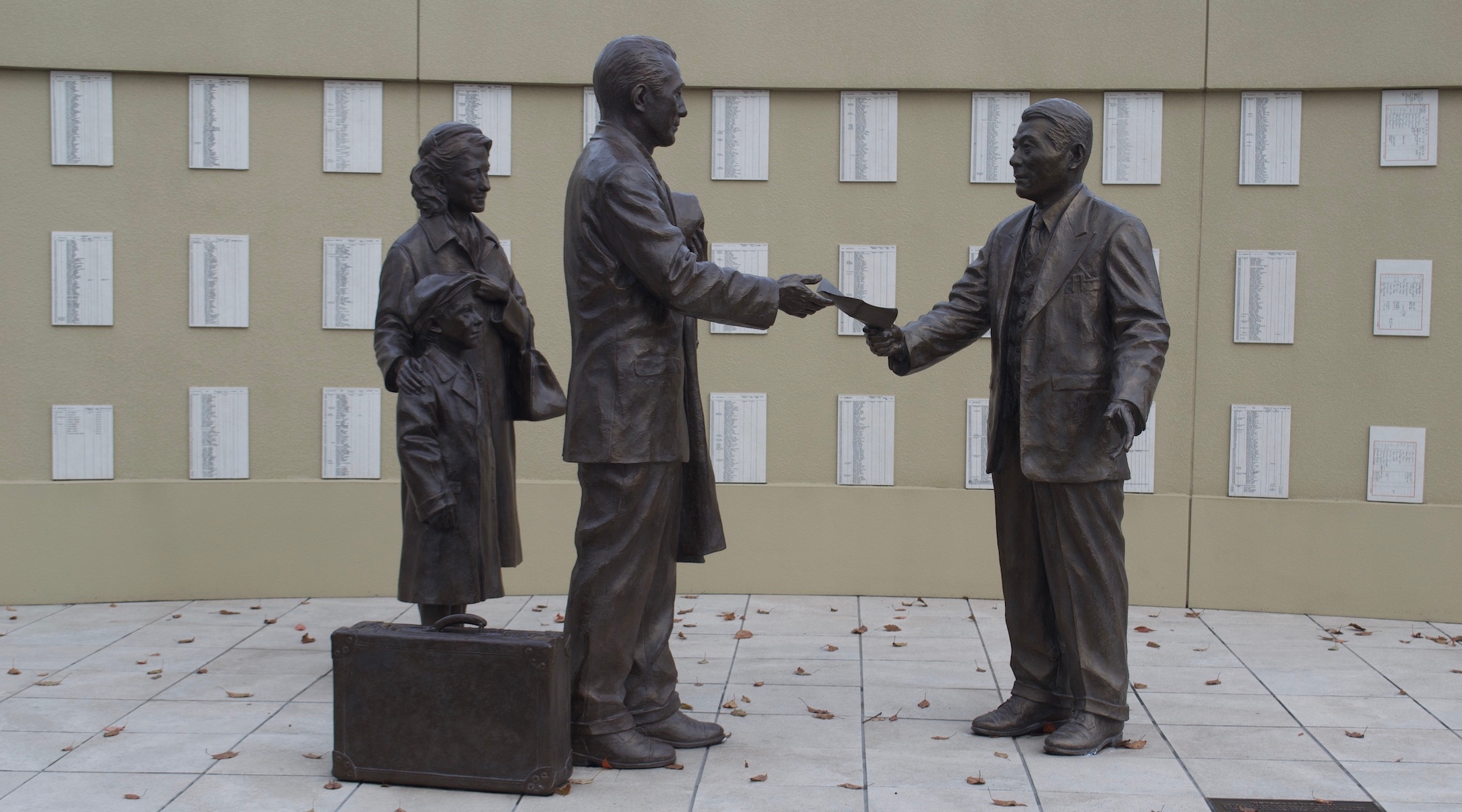
A memorial to Chiune Sugihara was established in 2018 outside of Sugihara’s former high school in Nagoya, Japan. A project of Nagoya’s board of education, the memorial space has hosted ambassadors from Lithuania and Israel. (Jordyn Haime)
The rise to stardom
A decade or two ago, a much smaller portion of Japanese society knew the Sugihara story. Today, he is a household name.
In a recent article for the academic journal American Historical Review, University of Haifa professor and prominent Japan scholar Rotem Kowner examined how Sugihara became a “Holocaust paragon of virtue.” Sugihara, he wrote, “was not the only consul to issue visas to Jews during this period, and not every consul who issued visas turned into a hero.”
As Japan rebuilt and rebranded into a peace-loving nation after the war, said Chiharu Inaba, a professor who researches Jewish refugees in Japan, “The people didn’t know what a hero was anymore. They needed a new hero.”
The legacy of Japan’s wartime actions, including its military’s sexual “comfort women” system, continues to hinder its relations with China and South Korea.
The start of Sugihara’s rise to hero status can be traced back to his nomination as one of Yad Vashem’s Righteous Among the Nations in 1968. According to Kowner’s research, Sugihara did not earn the honor for 16 years after his initial nomination because of Yad Vashem’s initial doubts over whether he risked his life or professional position to help Jews — normally a requirement of Righteous Among the Nations status. Instead, Sugihara was at first given a certificate of recognition for his actions.
Eventually, though, when a panel was presented with new evidence and testimony from survivors, it determined that Sugihara had taken a career risk, and his Righteous status was granted in 1984. Authorities also saw it as an opportunity to improve Israel’s image in Japan, Kowner argues, as Japanese public opinion about Israel had sharply deteriorated amid the conflict with Lebanon at the time.
A former head of Yad Vashem’s Righteous Among the Nations department recently disputed the claim that political considerations were involved in Sugihara’s nomination.
Recognition of Sugihara remained scant within Japan until 2000, when the Japanese government for the first time officially recognized him at a centennial celebration of his birth. But Prime Minister Shinzo Abe — known throughout his 2012-2020 tenure for his conservative politics, revisionist views of Japan’s World War II activities and desire to ramp up Japan’s military — embraced Sugihara more than any other Japanese leader.
In Sugihara, Abe saw an opportunity to not only boost diplomatic relations with Israel and Lithuania, but to make Sugihara a positive representative of the Japanese people in its darkest historical period.
But the process had already started before Abe’s tenure. In the 2000s, revisionist writers began adding Sugihara’s name into texts that denied the Nanjing Massacre — a Japanese attack on the Chinese city in 1937 that resulted in an estimated 300,000 deaths — “to show that wartime Japan did not resemble Nazi Germany,” Kowner wrote.
Sugihara has been a key component of what some have called Asia’s “memory competition” to have documents and memorials receive recognition from UNESCO, the United Nations’ cultural heritage authority. In 2017, Japan nominated Chiune Sugihara Memorial Hall, the museum at Sugihara’s supposed hometown in Yaotsu, for UNESCO Memory of the World status; the bid failed.
“Sugihara posthumously allowed his country to shed a long-lasting self-justifying policy of victimization and, instead, rebrand itself as possessing proactive humanitarian values,” Kowner wrote. “Critically, Japan could cast itself in the role of a ‘good’ country that helped the Jews rather than that of an Axis villain.”
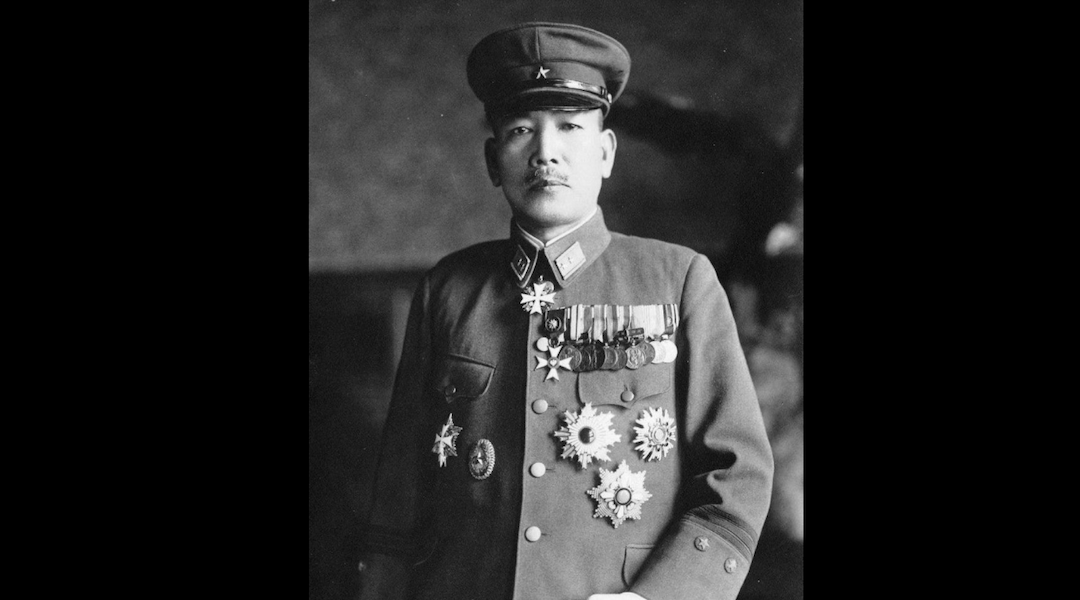
An undated photo of Kiichiro Higuchi. (Wikimedia Commons)
The next Sugihara
Sugihara’s vast fame has also paved the way for a new World War II-era Japanese hero to emerge: Kiichiro Higuchi.
Higuchi, a general, allegedly defied orders from his superiors to allow between 2,000 and 20,000 stranded Jewish refugees to cross the Russian border into Manchukuo, according to media reports and his supporters in Japan. This path to safety is now known as the “Higuchi route.”
Though far lesser known than Sugihara, efforts to attract attention to Higuchi have received mild success: through a manga series, media reports, and other commemoration efforts, such as a statue in his hometown of Awajishima. The Japanese embassy in Israel has reportedly been in discussions with Yad Vashem since 2005 about Higuchi’s Righteous Among the Nations status, but efforts have been unsuccessful.
When researchers began looking into the Higuchi story, it started to fall apart. Dylan Hallingstad O’Brien, a doctoral candidate at the University of California San Diego, has found that Higuchi likely facilitated the entrance of “at least 18 people” into Manchukuo. “There’s just no record” of more than that, O’Brien said.
“It just doesn’t add up that you have thousands and thousands of people flooding in and then there’s no record,” he said. “Especially when there are records of other Jewish refugee groups, [that have] receipts, letters, communications, and there’s just nothing for this group that supposedly went the ‘Higuchi route.’”
The website for the General Higuchi Association, an organization created to encourage the commemoration of Higuchi in Japan and pursue donations from abroad, is saturated with nationalism and false statements. Hideaki Kase — a right-wing politician who advised Shinzo Abe — chaired the association until his death last year.
“What would have happened if [Anne Frank’s] family knew of the ‘Higuchi Route’?” the website asks. “Perhaps the family would not have lived in the attic but instead would have sought passage for Manchuria, like so many other Jews did, and survived. At the time, neither the United States nor Britain accepted Jews; Japan was the only country in the world that opened its doors to Jews.”
The goal, O’Brien argued, is to promote the idea that Japan had a policy of racial harmony — in this case, of helping Jews during the war.
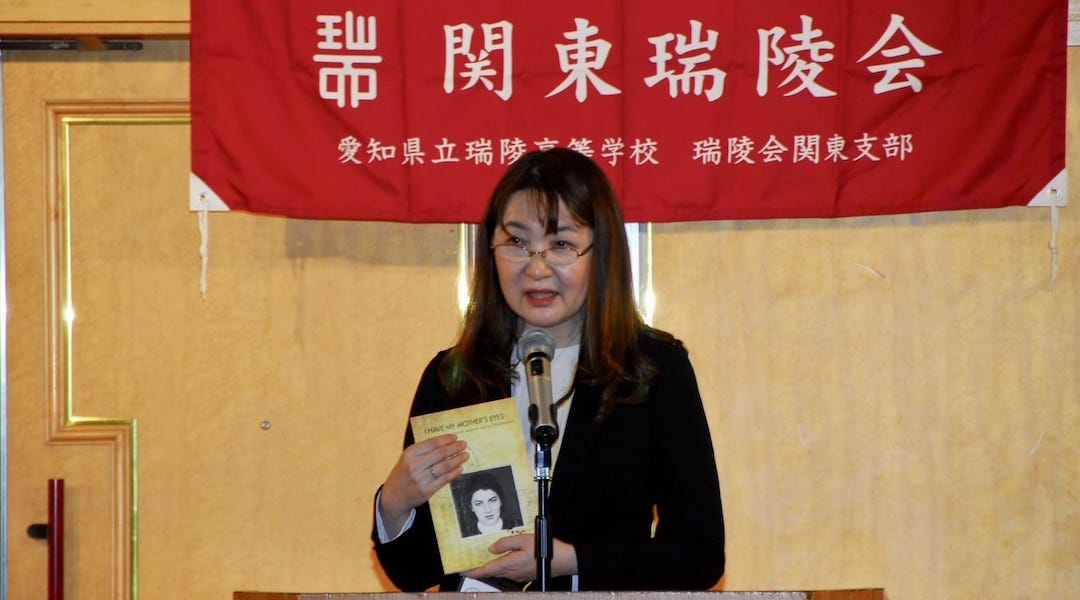
Madoka Sugihara says “the way the government changed their attitude” to her grandfather is “a very cynical thing.” (Courtesy of Madoka Sugihara)
The consequences
Japan is far from the only country that has faced criticism for promoting Holocaust narratives for nationalist ends that historians disagree with. Poland has been widely derided for denying the part that many Polish citizens played in the killing of local Jews throughout the war. And in China, Shanghai’s history as a former home to thousands of Jewish refugees has been used as a diplomatic tool, at times to deflect from international accusations of genocide against Muslim Uighurs in Xinjiang.
Small inconsistent details or a selective use and omission of certain facts can be dangerous, Jocubowicz said. Holes in Holocaust stories give antisemites and Holocaust deniers ammunition for their arguments that Jews were not in danger, he argued.
“What happens if something is inaccurate and could be corrected is then the readers have no idea whether anything in the story is accurate,” Jocubowicz says. “So anything could be a fake. Maybe it’s all a fake, and maybe this is a signal that the whole Jewish story about the Holocaust is rubbish.”
Rabbi Mendy Sudakevich, a Chabad-Lubavitch movement emissary who has been living in Tokyo since the 1990s, sees the narrative differently. He thinks that the Sugihara story — whether it is 100% true or not — has a positive effect on people and endears them to Jews.
“Kids in Japan grew up not knowing what Japan did in the war. They don’t know the story. And Japan tried to build up a new story,” Sudakevich said. “I want the new generation of Japan to know that saving Jews is an important task. I want them to know that. And if that’s what they know about World War II, it is a good result for me.”
When Russia invaded Ukraine in 2022, many in Japan ventured out to Yaotsu, Kobe or Tsuruga to learn more about Sugihara. Invoking his memory, Inaba and his university students have organized a 5 million yen ($37,490) donation drive for Ukrainian refugees dubbed “donations for life.” The Visas for Life organization, founded by the Sugihara family in 2000, has raised 1.7 million yen ($12,746) for Ukrainian evacuees now living in Japan.
Madoka Sugihara, Chiune Sugihara’s granddaughter and soon-to-be-director of Sugihara Visas for Life, noted the dramatic change in the government’s reception of Sugihara in the past several years.
“The way the government changed their attitude is a very cynical thing,” but “it is a good thing that they regard Sugihara-san’s act very fairly. I’m convinced that it’s a good thing,” she said.
JTA has documented Jewish history in real-time for over a century. Keep our journalism strong by joining us in supporting independent, award-winning reporting.
